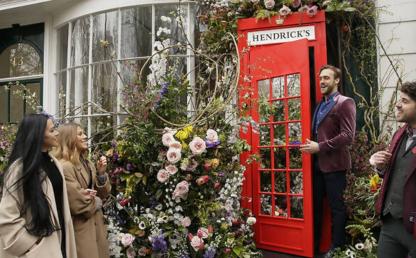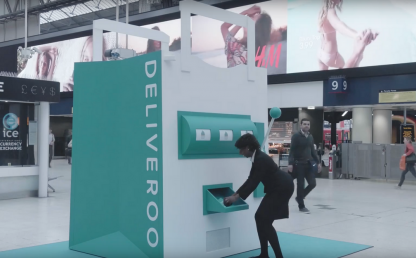Experiential Trends Report

Innovative tech is shaking up the world of experiential marketing. At Catalyst, technology advancements are at the forefront of our business. We use our creativity to wield new technology into cutting-edge marketing campaigns that create unforgettable experiences. Here we’ll reveal the five experiential trends all companies should know to keep customers flocking to your brand.
1. AR Filters
Augmented reality (AR) filters superimpose virtual video or computer-generated effects on top of real-world images or live videos to create a combined effect in real-time. We have all seen the IG stories of our friends and celebrities with virtual bunny ears or puppy noses, right? Well, they go far beyond that now. AR filters have become hugely popular on social media platforms, namely Facebook, Instagram, and Snapchat, and are a powerful experiential marketing tool for brands.
A landmark milestone in the development of AR filters happened in May of 2018 when Facebook created Spark AR, a tool for creating augmented reality effects. The platform was initially limited to approved creators, and by April, Facebook reported that 1 billion people had interacted with AR effects from the Spark AR platform.
The next big milestone happened on August when Facebook opened Spark AR up to everyone. Now anyone can make custom face filters and effects for Instagram Stories. This makes it even easier for any brand to incorporate AR filters into their marketing campaigns.
How can AR filters help my brand?
AR filters are helpful for brands for several reasons.
First, they are interactive and fun. Users get to be the star of the show while your brand makes impressions.
Second, people often want to share the content of them using the filter with their network which helps your brand to reach a larger audience.
Third, users have to follow the creator of an AR filter (your brand) to use it. Once a creator is followed, the effects automatically show up in the user’s camera effects tray in IG Stories. This helps you to grow your follower base.
So AR filters help to engage customers in a fun way, improve a brand’s reach, and grow their audience. What a trifecta!
While the AR filter trend is not necessarily new, AR filters are now reaching a whole new level with the open access.
Use Cases for AR filters in Marketing
Here are a few examples of how brands are using AR filters.
1. Laneige Sparkle My Way
Laneige is a Koran make-up brand with users that felt apprehensive about buying their make-up because they weren’t sure if it would look good. The brand created a Facebook AR filter which enables users to ‘try on’ three types of lipstick, eye makeup and blush using their Facebook camera. Laneige encourages users to find the combinations that they like best and to share their pictures and videos for a chance to win the products. Laneige launched a social media campaign that involved six local influencers and a series of posts to promote the filter.
2. Gucci Beauty
Gucci Beauty, Gucci’s Instagram account, jumped on the AR Filter train with a filter that let you choose from three looks inspired by the baroque and renaissance eras. Users can see themselves with large heads of hair, possibly a mustache, and Gucci accessories- of course.
3. Adidas
Adidas took note of the retro trend and created an AR filter that gives videos an amateur camcorder feel from the ’80s and ’90s. If the user raises their eyebrows, it causes what looks like a glitch which briefly shows the Adidas Originals logo.
The key to success with AR filters is staying in tune with current content trends, making your filter fun and shareable for the user, and working your brand in subtly. The user should always be the focus.
2. AI
Artificial intelligence (AI) is the creation of intelligent machines that can work and react like humans. It interacts in a way that feels natural, grasps complex concepts, extracts insights from data, and understands, learns, interprets, and reasons. Applied to marketing, AI can help brands identify new customer segments, scale personalization, and unify their marketing and analytics.
Market research firm TechNavio reports that the U.S. AI market is expected to grow at CAGR of about 50% through 2021 so it’s best to be aware of the possibilities and how you can integrate them into your campaigns.
Use Cases for AI in Marketing
The loneliest place to be can be in a sea of strangers. At events, attendees are often flying solo and can feel disconnected from the brand, the message, and other attendees.
Personalization through AI is key for making attendees feel comfortable and a part of the event.
This can involve:
Acknowledging returning attendees based on data gathered and interpreted from previous events. Scheduling “orientations” for new attendees. Serving up suggested content based on attendee data gathered through wearables. Using registrant data to find the best possible match combinations for networking. Saving on temporary staff by automatically checking in attendees, offering customer support, and managing employees with chatbots. Anticipatory computing can notify your brand about problems before they start such as running out of product samples, cups, or swag. Monitoring sentiments passively using social media and facial recognition. Eliminating barriers in communication from language. Eliminating lines for customers using facial recognition and more.
AI can also be used to create surprise-and-delight experiences. Imagine turning up to an event with an entrance wall that welcomes you personally and shows you content that is individually relevant to you. At Catalyst, we can help you harness the power of AI to streamline and enhance your marketing campaigns.
3. Interactive Video
By this year, 74% of all internet traffic was predicted to be video content. Further, by 2020, 75% of mobile data traffic was video.” While text-based written content has stuck around longer than many envisioned, video is surely on the rise. There’s no denying the impact and importance it has. Look at how video has permeated all social media channels, websites, and even emails.
In the marketing sphere, we know that active involvement makes for a more memorable and impactful experience for the audience, so we believe it’s important to take video a step further. Brands should be strategizing ways to create video experiences that let viewers make a decision, choose the ‘fate’ of the video, and feel involved in their storytelling. This helps to capture the viewer’s attention and help them feel more connected to the brand.
Use Cases for Interactive Video in Marketing
We live in a time where we have to compete for our audience's attention. With no shortage of videos, an interactive component can make yours stand out. You can ask viewers questions and can even tailor the content based on the answers. Here are a few real-life examples:
1. SPP: Earth 2045
SPP is a Swedish management company. It launched an interactive sliding video to encourage its young audience to invest sustainably in order to ensure there will be a world to enjoy when they retire. The video dramatized how small choices made today have big impacts for the year 2045. It split the screen down the middle to show two fictitious future realities side-by-side; one utopian and one dystopian. The viewer could slide left or right to see more of either scenario.
2. Bob Dylan and Sony
Bob Dylan and Sony used an interactive video to promote the release of his CD Box set. They created a music video of the song “Like a Rolling Stone” which lets the viewer flip through 16 different channels. Each channel had different characters lip-syncing the song. This helped to get the attention of their audience and share the announcement.
Want to create your own? Catalyst thinks outside the box to help brands create interactive videos that will grab their audience’s attention and delight them throughout the experience.
4. Engage the Senses
Next, experiential marketing is no longer one-dimensional. It’s time to engage the senses to capture the attention and trust of customers. The more senses you engage, the more powerful of an impact you can have. Take, for example, the fact that that pleasant smells can improve mood by 40%. Further, humans are 100 times more likely to remember something they smell rather than something we hear, see, or touch. Incorporating a smell and other senses into an experiential campaign can be a game-changer.
Use Cases for Sensory Experiences in Marketing
1. Diageo
Whiskey-brand Diageo experimented with how the environment can impact the taste and enjoyment of their whiskey. They did this by setting up a pop-up bar with three rooms, each with different sounds, visuals, and smells, designed to enhance the different flavours of the malt whiskey. They found the environment could positively influence both taste and enjoyment by up to 20%.
2. Glade
Next, home fragrance brand Glade hosted a pop-up that involved five different rooms, each inspired by a particular Glade candle scent. The purpose was to drive sales and bring the brand off-the-shelf and into real life. Each room was designed to evoke an emotional response and featured messaging that asked, “What will you feel?” Guests were invited to share photos to social media with the hashtag #feelglade.
3. Dunkin’ Donuts
Dunkin’ Donuts used sensory marketing as part of its campaign in South Korea by releasing the smell of coffee into the air while playing its jingle.
Today, brands need to be thinking about how to creatively incorporate sight, sound, taste, touch, and taste to create rich, positive, multi-sensory experiences that drive positive customer emotions and impressions.
5. Robotics
Lastly, it’s been suggested that this year could be the year that we see robotics incorporated into experiential marketing, offering companies an innovative way of engaging with consumers.
Robot Uses Cases in Marketing
How might you incorporate a robot into your event?
Customer engagement: From a hospitality robot that welcomes attendees to an entertainment one that animates the venue.
Information: Robots can be used to provide, collect, or display information.
Social media integration: A robot can take group pictures, videos, or even live stream to social media platforms like Facebook and Periscope.
Here is a real-life example:
Bloomberg
Bloomberg attended the E World Energy and Water Conference, an international trade fair, to share their latest tech and products. However, they didn’t just bring their human team, they also brought along an interactive event robot. The robot helped to attract people to their stand, increase brand awareness, and educate the audience about their core message. It was fully branded in Bloomberg’s logo and colors and would also deliver brochures, surveys, and premium items. The experience brought an element of novelty and excitement which encouraged participation and interaction with the brand.
We now have the tech to successfully incorporate robots into marketing campaigns as a way to create interest in brands and can do so to make an unforgettable impression.
Create Experiential Marketing Campaigns Your Audience Can’t Forget
This is a year when it is more important than ever for brands to differentiate themselves through effective marketing campaigns in order to stand out. You can’t do the same old thing or copy what someone else is doing and expect to get noticed. At Catalyst, we believe in staying on the cusp of technological developments and using the latest innovations to create unforgettable marketing experiences. If your brand would like to incorporate these trends and more into your strategy, contact our experienced team at Catalyst today to help you do so successfully.
 Insights
Insights

